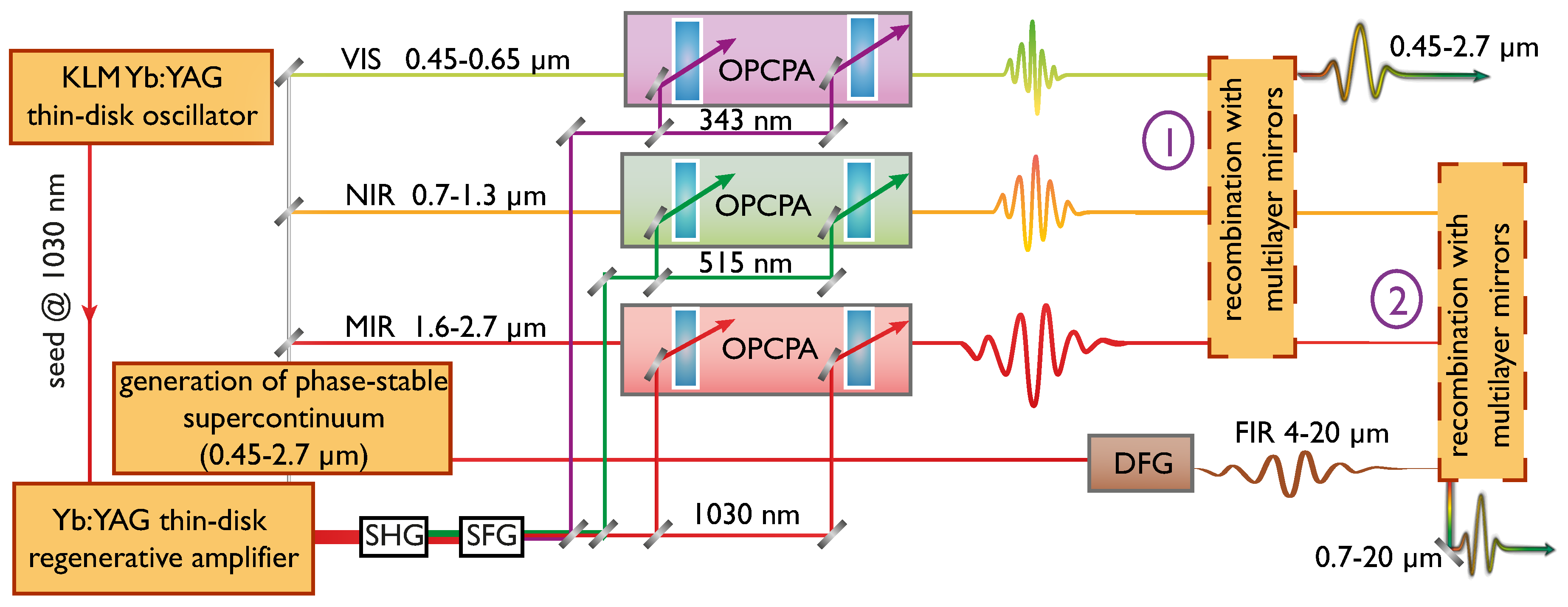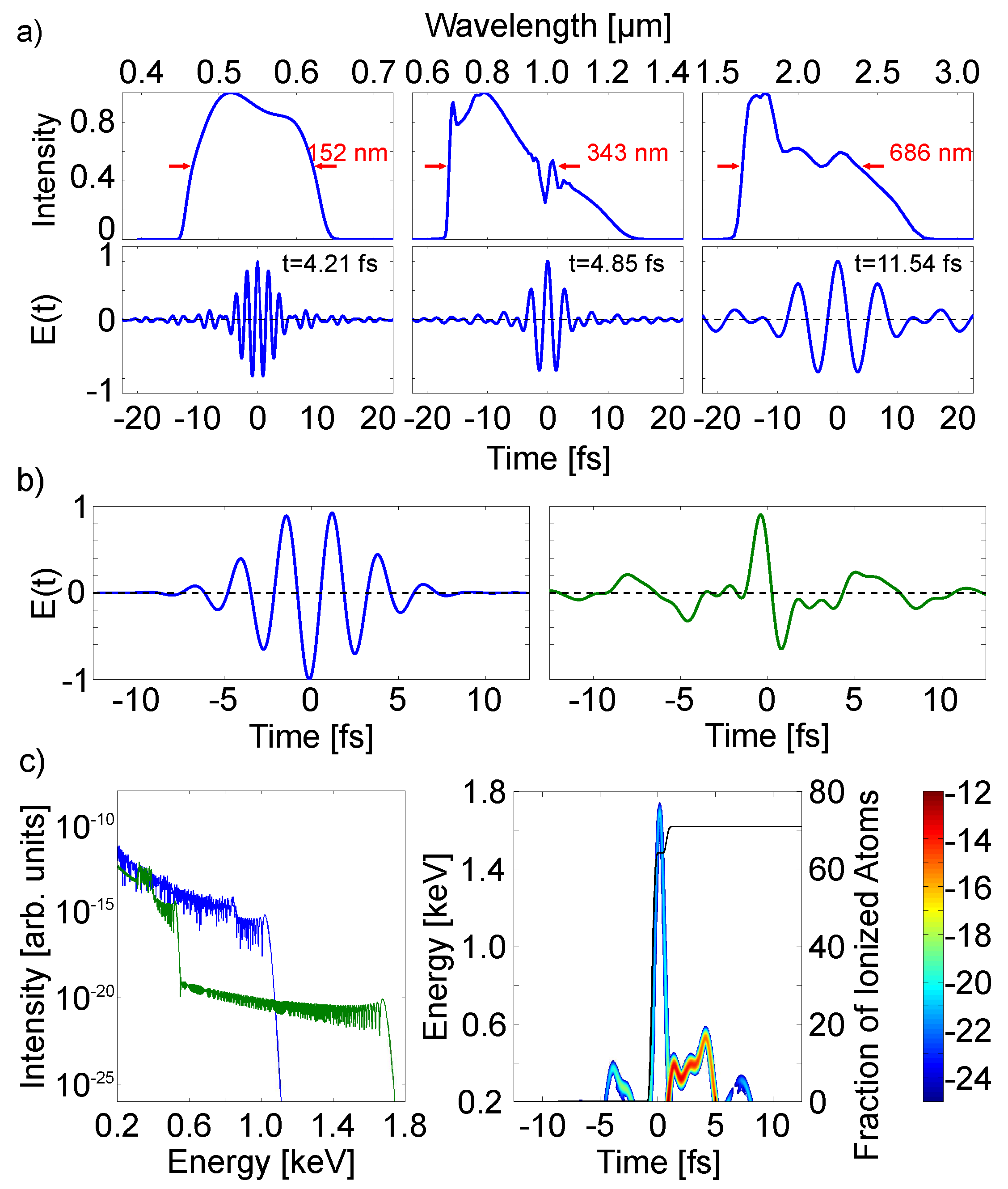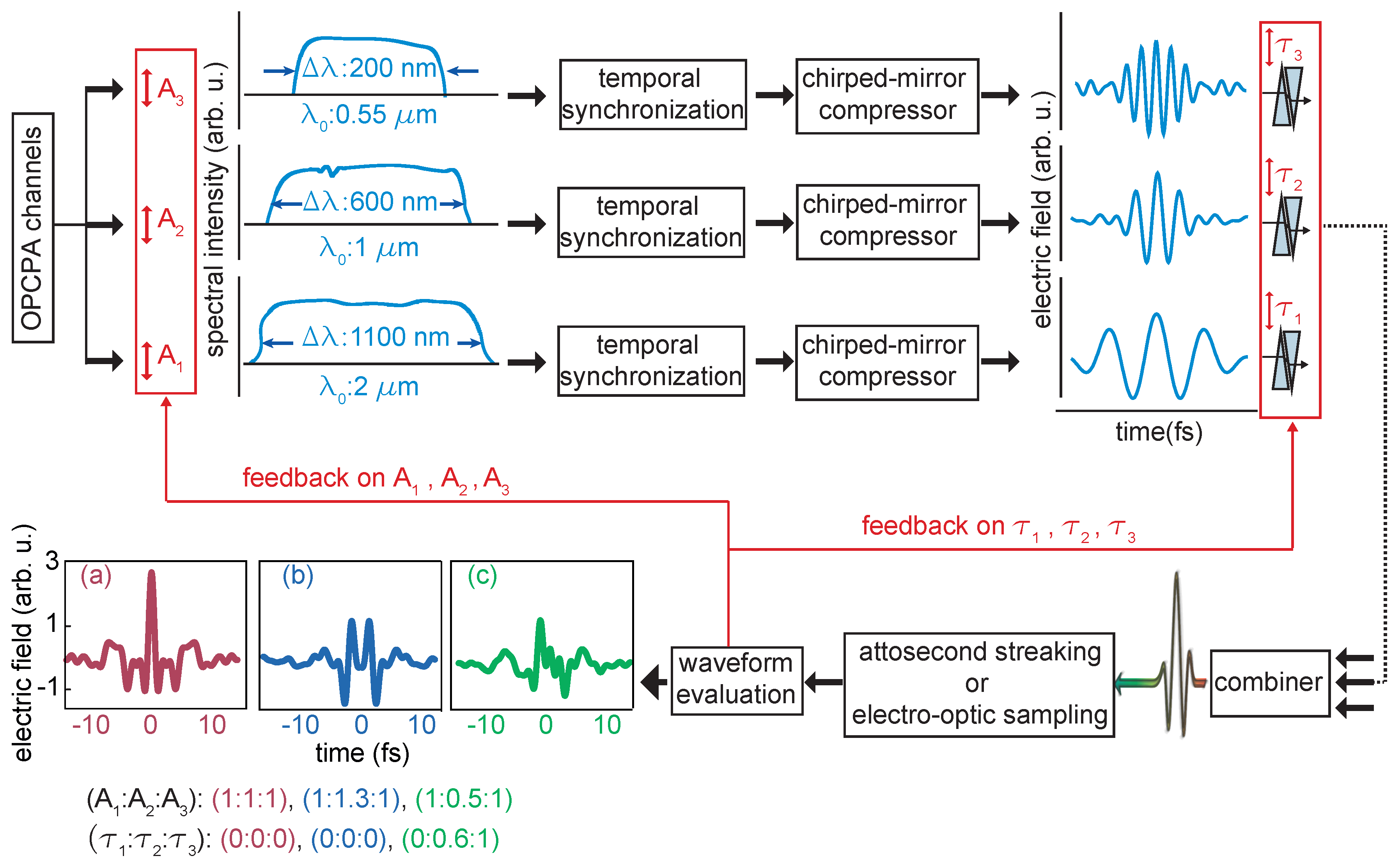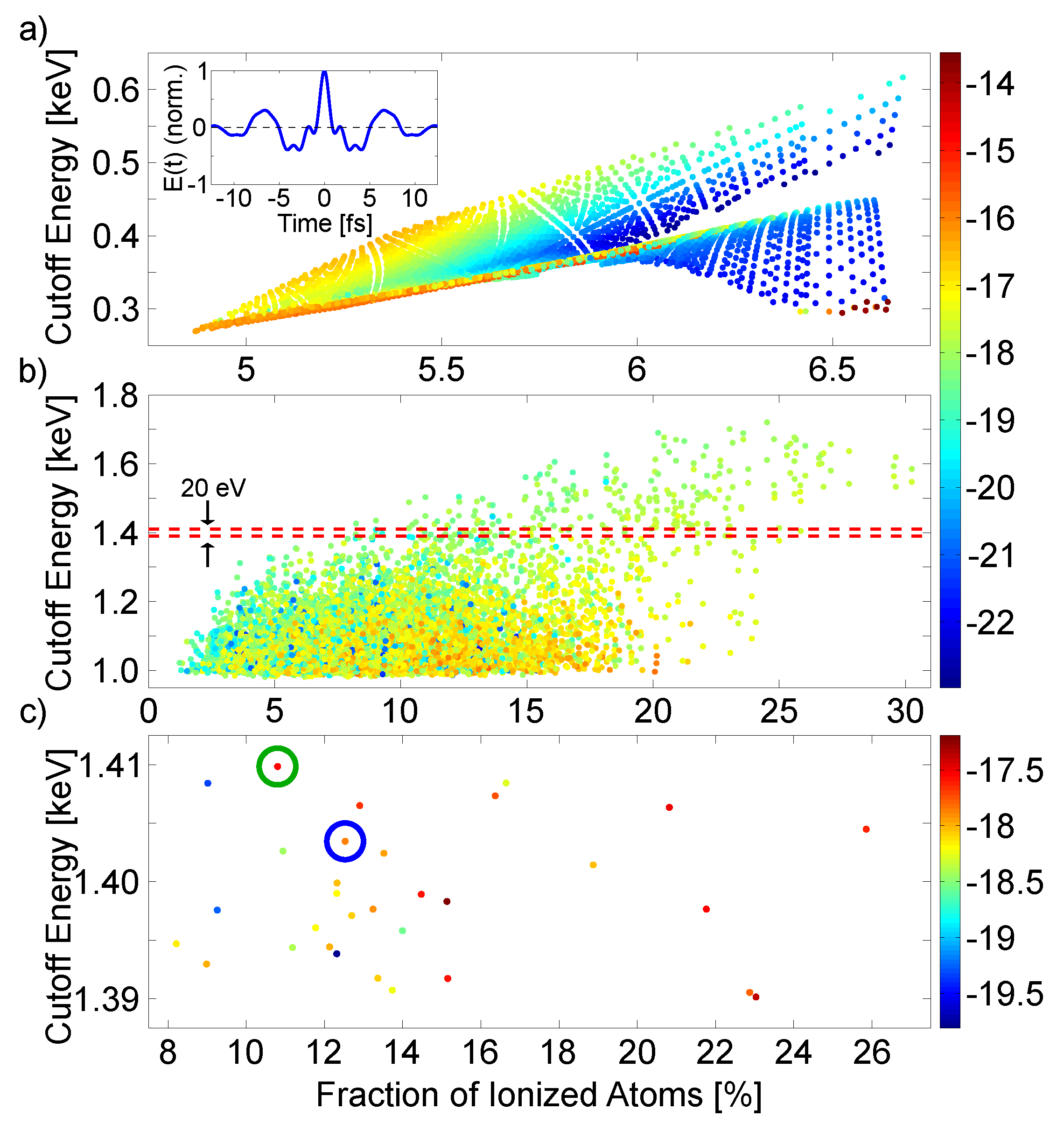Theoretical Study: High Harmonic Generation by Light Transients
Abstract
:1. Introduction
2. Method
2.1. Dipole Response Calculation
2.2. Pulse Synthesis
2.3. Scanning the Amplitude and the Delay
2.4. Ionization Rate
2.5. Spectrogram
2.6. Electron Trajectories
3. Results and Discussion
4. Conclusions
Author Contributions
Acknowledgments
Conflicts of Interest
References
- Krausz, F.; Stockman, M.I. Attosecond metrology: from electron capture to future signal processing. Nat. Photonics 2014, 8, 205–213. [Google Scholar] [CrossRef]
- Krausz, F.; Ivanov, M. Attosecond physics. Rev. Mod. Phys. 2009, 81, 163–234. [Google Scholar] [CrossRef]
- Wirth, A.; Hassan, M.T.; Grguras, I.; Gagnon, J.; Moulet, A.; Luu, T.T.; Pabst, S.; Santra, R.; Alahmed, Z.A.; Azzeer, A.M.; et al. Synthesized light transients. Science 2011, 334, 195–200. [Google Scholar] [CrossRef] [PubMed]
- Popmintchev, T.; Chen, M.C.; Popmintchev, D.; Arpin, P.; Brown, S.; Alisauskas, S.; Andriukaitis, G.; Balciunas, T.; Mücke, O.D.; Pugzlys, A.; et al. Bright coherent ultrahigh harmonics in the keV X-ray regime from mid-infrared femtosecond lasers. Science 2012, 336, 1287–1291. [Google Scholar] [CrossRef] [PubMed]
- Gordon, A.; Kärtner, F.X. Scaling of keV HHG photon yield with drive wavelength. Opt. Express 2005, 13, 2941–2947. [Google Scholar] [CrossRef] [PubMed]
- Moulet, A.; Tosa, V.; Goulielmakis, E. Coherent kiloelectronvolt X-rays generated by subcycle optical drivers: A feasibility study. Opt. Lett. 2014, 39, 6189–6192. [Google Scholar] [CrossRef] [PubMed]
- Geissler, M.; Tempea, G.; Brabec, T. Phase-matched high-order harmonic generation in the nonadiabatic limit. Phys. Rev. A 2000, 62, 033817. [Google Scholar] [CrossRef]
- Tosa, V.; Kim, K.T.; Nam, C.H. Macroscopic generation of attosecond-pulse trains in strongly ionized media. Phys. Rev. A 2009, 79, 043828. [Google Scholar] [CrossRef]
- Popmintchev, D.; Hernandez-Garcia, C.; Dollar, F.; Mancuso, C.; Perez-Hernandez, J.A.; Chen, M.C.; Hankla, A.; Gao, X.; Shim, B.; Gaeta, A.L.; et al. Ultraviolet surprise: Efficient soft X-ray high-harmonic generation in multiply ionized plasmas. Science 2015, 350, 1225–1231. [Google Scholar] [CrossRef] [PubMed]
- Takahashi, E.J.; Lan, P.; Mücke, O.D.; Nabekawa, Y.; Midorikawa, K. Attosecond nonlinear optics using gigawatt-scale isolated attosecond pulses. Nat. Commun. 2013, 4, 1–9. [Google Scholar] [CrossRef] [PubMed]
- Jin, C.; Wang, G.; Le, A.T.; Lin, C.D. Route to optimal generation of soft X-ray high harmonics with synthesized two-color laser pulses. Sci. Rep. 2015, 4, 7067. [Google Scholar] [CrossRef] [PubMed]
- Bandulet, H.C.; Comtois, D.; Bisson, E.; Fleischer, A.; Pépin, H.; Kieffer, J.C.; Corkum, P.B.; Villeneuve, D.M. Gating attosecond pulse train generation using multicolor laser fields. Phys. Rev. A 2010, 81, 013803. [Google Scholar] [CrossRef]
- Haessler, S.; Balčiunas, T.; Fan, G.; Andriukaitis, G.; Pugžlys, A.; Baltuška, A.; Witting, T.; Squibb, R.; Zaïr, A.; Tisch, J.W.G.; et al. Optimization of Quantum Trajectories Driven by Strong-Field Waveforms. Phys. Rev. X 2014, 4, 021028. [Google Scholar] [CrossRef]
- Kim, I.J.; Kim, C.M.; Kim, H.T.; Lee, G.H.; Lee, Y.S.; Park, J.Y.; Cho, D.J.; Nam, C.H. Highly Efficient High-Harmonic Generation in an Orthogonally Polarized Two-Color Laser Field. Phys. Rev. Lett. 2005, 94, 243901. [Google Scholar] [CrossRef]
- Brizuela, F.; Heyl, C.M.; Rudawski, P.; Kroon, D.; Rading, L.; Dahlström, J.M.; Mauritsson, J.; Johnsson, P.; Arnold, C.L.; L’Huillier, A. Efficient high-order harmonic generation boosted by below-threshold harmonics. Sci. Rep. 2013, 3, 1410. [Google Scholar] [CrossRef] [PubMed]
- Huang, S.W.; Cirmi, G.; Moses, J.; Hong, K.H.; Bhardwaj, S.; Birge, J.R.; Chen, L.J.; Li, E.; Eggleton, B.J.; Cerullo, G.; et al. High-energy pulse synthesis with sub-cycle waveform control for strong-field physics. Nat. Photonics 2011, 5, 475–479. [Google Scholar] [CrossRef]
- Fattahi, H. Sub-cycle light transients for attosecond, X-ray, four-dimensional imaging. Contemp. Phys. 2016, 57, 580–595. [Google Scholar] [CrossRef]
- Fattahi, H.; Barros, H.G.; Gorjan, M.; Nubbemeyer, T.; Alsaif, B.; Teisset, C.Y.; Schultze, M.; Prinz, S.; Haefner, M.; Ueffing, M.; et al. Third-generation femtosecond technology. Optica 2014, 1, 45–63. [Google Scholar] [CrossRef]
- Mucke, O.D.; Fang, S.; Cirmi, G.; Rossi, G.M.; Chia, S.H.; Ye, H.; Yang, Y.; Mainz, R.; Manzoni, C.; Farinello, P.; et al. Toward Waveform Nonlinear Optics Using Multimillijoule Sub-Cycle Waveform Synthesizers. IEEE J. Sel. Top. Quantum Electron. 2015, 21, 1–12. [Google Scholar] [CrossRef] [Green Version]
- Fattahi, H.; Alismail, A.; Wang, H.; Brons, J.; Pronin, O.; Buberl, T.; Vámos, L.; Arisholm, G.; Azzeer, A.M.; Krausz, F. High-power, 1-ps, all-Yb:YAG thin-disk regenerative amplifier. Opt. Lett. 2016, 41, 1126–1129. [Google Scholar] [CrossRef] [PubMed]
- Fattahi, H.; Wang, H.; Alismail, A.; Arisholm, G.; Pervak, V.; Azzeer, A.M.; Krausz, F. Near-PHz-bandwidth, phase-stable continua generated from a Yb:YAG thin-disk amplifier. Opt. Express 2016, 24, 24337–24346. [Google Scholar] [CrossRef] [PubMed]
- Amotchkina, T.; Fattahi, H.; Pervak, Y.A.; Trubetskov, M.; Pervak, V. Broadband beamsplitter for high intensity laser applications in the infra-red spectral range. Opt. Express 2016, 24, 16752–16759. [Google Scholar] [CrossRef] [PubMed]
- Fattahi, H.; Wang, H.; Alismail, A.; Krausz, F. Towards high-power, multi-TW light transients. In Proceedings of the Conference on Lasers Electro-Optics, San Jose, CA, USA, 5–10 June 2016; OSA: Washington, DC, USA, 2016; p. SM1M.6. [Google Scholar] [CrossRef]
- Chipperfield, L.; Robinson, J.; Tisch, J.; Marangos, J. Ideal Waveform to Generate the Maximum Possible Electron Recollision Energy for Any Given Oscillation Period. Phys. Rev. Lett. 2009, 102, 0630031–0630034. [Google Scholar] [CrossRef] [PubMed]
- Högner, M. Available online: https://gitlab.com/mhoegner/HHGmax (accessed on 2 May 2018).
- Tong, X.M.; Lin, C.D. Empirical formula for static field ionization rates of atoms and molecules by lasers in the barrier-suppression regime. J. Phys. B 2005, 38, 2593–2600. [Google Scholar] [CrossRef]
- Lewenstein, M.; Balcou, P.; Ivanov, M.Y.; L’Huillier, A.; Corkum, P.B. Theory of high-harmonic generation by low-frequency laser fields. Phys. Rev. A 1994, 49, 2117–2132. [Google Scholar] [CrossRef] [PubMed]
- Popmintchev, T.; Chen, M.C.; Bahabad, A.; Gerrity, M.; Sidorenko, P.; Cohen, O.; Christov, I.P.; Murnane, M.M.; Kapteyn, H.C. Phase matching of high harmonic generation in the soft and hard X-ray regions of the spectrum. Proc. Natl. Acad. Sci. USA 2009, 106, 10516–10521. [Google Scholar] [CrossRef] [PubMed]
- Hentschel, M.; Kienberger, R.; Spielmann, C.; Reider, G.A.; Milosevic, N.; Brabec, T.; Corkum, P.; Heinzmann, U.; Drescher, M.; Krausz, F. Attosecond metrology. Nature 2001, 414, 509–513. [Google Scholar] [CrossRef] [PubMed]
- Keiber, S.; Sederberg, S.; Schwarz, A.; Trubetskov, M.; Pervak, V.; Krausz, F.; Karpowicz, N. Electro-optic sampling of near-infrared waveforms. Nat. Photonics 2016, 10, 159–162. [Google Scholar] [CrossRef]
- Jin, C.; Wang, G.; Wei, H.; Le, A.T.; Lin, C.D. Waveforms for optimal sub-keV high-order harmonics with synthesized two- or three-colour laser fields. Nat. Commun. 2014, 5, 4003. [Google Scholar] [CrossRef] [PubMed]
- Siegel, T.; Torres, R.; Hoffmann, D.J.; Brugnera, L.; Procino, I.; Zaïr, A.; Underwood, J.G.; Springate, E.; Turcu, I.C.E.; Chipperfield, L.E.; et al. High harmonic emission from a superposition of multiple unrelated frequency fields. Opt. Express 2010, 18, 6853–6862. [Google Scholar] [CrossRef] [PubMed]
- Watanabe, S.; Kondo, K.; Nabekawa, Y.; Sagisaka, A.; Kobayashi, Y. Two-Color Phase Control in Tunneling Ionization and Harmonic Generation by a Strong Laser Field and Its Third Harmonic. Phys. Rev. Lett. 1994, 73, 2692–2695. [Google Scholar] [CrossRef] [PubMed]
- Corkum, P. Plasma perspective on strong field multiphoton ionization. Phys. Rev. Lett. 1993, 71, 1994–1997. [Google Scholar] [CrossRef] [PubMed]
- Schafer, K.J.; Kulander, K.C. High Harmonic Generation from Ultrafast Pump Lasers. Phys. Rev. Lett. 1997, 78, 638–641. [Google Scholar] [CrossRef]





| Case | Ionization Rate | Intensity (×1014) | Yield (arb. Units) |
|---|---|---|---|
| 1 | 0.01% | 3.5 | 0.0006 |
| 2 | 99% | 52.8 | 1.05 |
| 3 | 70% | 52.8 | 1.05 |
| 4 | 16% | 13.9 | 41 |
| 5 | 17.4% | 13.5 | 46 |
| 6 | 24.5% | 15 | 78 |
© 2018 by the authors. Licensee MDPI, Basel, Switzerland. This article is an open access article distributed under the terms and conditions of the Creative Commons Attribution (CC BY) license (http://creativecommons.org/licenses/by/4.0/).
Share and Cite
Wendl, M.; Högner, M.; Fattahi, H. Theoretical Study: High Harmonic Generation by Light Transients. Appl. Sci. 2018, 8, 728. https://doi.org/10.3390/app8050728
Wendl M, Högner M, Fattahi H. Theoretical Study: High Harmonic Generation by Light Transients. Applied Sciences. 2018; 8(5):728. https://doi.org/10.3390/app8050728
Chicago/Turabian StyleWendl, Maximilian, Maximilian Högner, and Hanieh Fattahi. 2018. "Theoretical Study: High Harmonic Generation by Light Transients" Applied Sciences 8, no. 5: 728. https://doi.org/10.3390/app8050728






